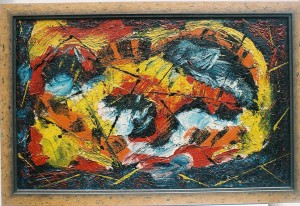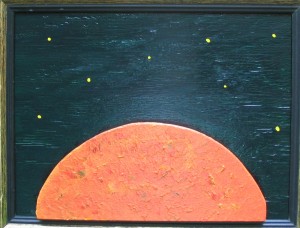People who have visited our home over the years have witnessed every available wall space filled with artwork. When questioned, we have to admit that most of it is mine.
I began painting in oils spontaneously as a teenager, and I loved the French Impressionists. In three trips to Europe beginning in 1958, I was drawn to the art collections of the major museums in Amsterdam, Paris, London, Milan, Vienna, Copenhagen, and Stockholm.
In Sweden and Denmark as a postgraduate Bauhaus Situationiste fellow, I lived in the home of writer and artist Jorgen Nash whose brother, famed Danish abstractionist Asger Jorn, maintained a summer studio. It was in that studio that I renewed my drive to create visual arts. My artwork came to the attention of the leading modern art critic in Denmark—Jens Jorgen Thorsen—who encouraged me to work fulltime in oils, inks, and watercolors in preparation for a public gallery exhibition.
By 1964, I was getting a lot of media attention, and my paintings were purchased by two museums and by a Swedish Countess. I found myself in association with some of the most important European fine artists who had founded the historic COBRA and Situationiste Internationale art movements. These avant-garde movements were protests against the practice of establishment academies dictating what was and was not fine art. Artists who were non-conformists were thus excluded from the commercial art world. With no formal academic art degrees, I, too, was assumed to be a protest artist. My sudden fame in Scandinavia, however, came to an abrupt end when I was drafted into the US Army.
Out of the Army and home in Virginia, I had a one-man exhibition of my abstract paintings in 1967; but married and with a child on the way, I had to devote myself to magazine journalism to make a living. Then, after a 40-year hiatus, I started painting again.
At first, the work resembled my European influences, but soon I was experimenting with new styles and materials. My Woodhaven Series of 2007, for example, is very naturalistic in its use of construction board and color patterning. The primary objective in these initial paintings was to see if I could restore a sense of movement and depth to a flat surface, the qualities that had first attracted critics and buyers to my artwork.
Other new works demonstrated a Native American influence by the use of leather, feathers, and beads.
The Yellow Circle Series of five paintings took a full year to complete because of their complex geometric designs.
An experiment involving night sky paintings with wooden relief “moon” discs led to another series in 2010-2011.
My art studio consists of a garage and a covered deck space where I work outdoors weather permitting. I have also done a few assemblage sculptures that have been positioned in our woods. Every summer I encourage our grandchildren to come for brief instructions followed by days free to use my paints, brushes, and pallet knives on canvas and wood surfaces. Their home bedrooms are now decorated by my work as well as their own. Some pieces we do together.
Although we do not sell the artwork created in the mid-1960s, more than a dozen paintings of the new era have gone to private collectors in the Washington, DC, Chicago, and Knoxville areas.














